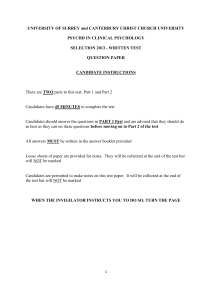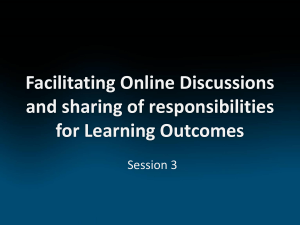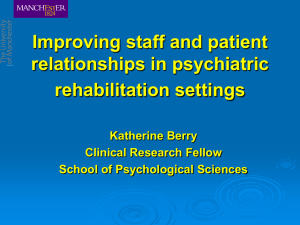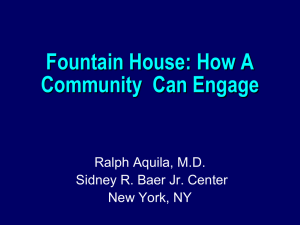Feasibility and acceptability of a nurse
advertisement
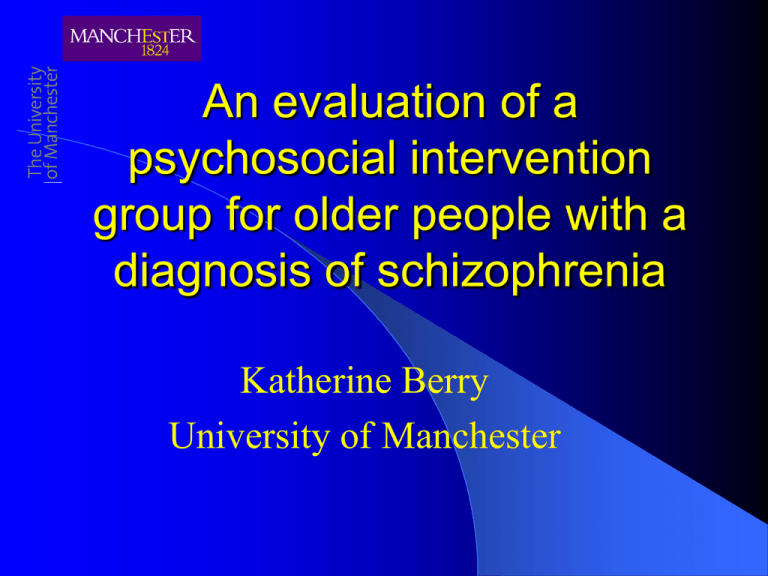
An evaluation of a psychosocial intervention group for older people with a diagnosis of schizophrenia Katherine Berry University of Manchester Acknowledgements Service users who participated and their care co-ordinators Tony Ellis, Michelle O’Donal, Ellie Brew and Katherine McIvor Christine Barrowclough, Nitin Purandare, Richard Drake, Richard Emsley, Lisa Jones and Katherine O’Neill Beryl Clarke, Catherine Cross and Julie Colville and Janet Costello The BUPA Foundation Outline Background and aims Methods Intervention Key findings Discussion and further work Background Good evidence for psychological interventions in psychosis (e.g. Wykes et al., 2008), but large trials often exclude older people. Older adults may have different needs e.g. may need adaptations to format and different focus (Berry & Barrowclough, 2009). Group-based psychosocial interventions for older adults with schizophrenia in US (Granholm et al., 2005; Patterson et al., 2006; Mueser et al., 2010). Background Large trials of these interventions show positive effects on social and/or independent living skills (Granholm et al., 2005; Patterson et al., 2006; Mueser et al., 2010). But interventions focused on didactic teaching of skills, whereas psychological treatments in the UK are collaborative and value service user expertise (e.g. Barrowclough et al., 2006). Aims Using UK and US expertise develop an intervention tailored to the needs of older adults with schizophrenia in NHS settings. Assess the feasibility and acceptability of intervention by running one group in North Manchester. Develop an intervention and research protocol for a larger evaluation of the intervention. Method Amended US manuals through consultation with working groups of UK researchers, clinicians and service users. Selected US modules that were most relevant to older people’s needs in UK, included modules on self-esteem and goals for the future and emphasised service user expertise in their experiences. Indentified three facilitators from the local Trust to co-run the groups. Method Participants recruited from old age and adult psychiatry services. Inclusion criteria: - Diagnosis of schizophrenia - 55 years or older - Informed consent - English speaking - Able to complete study questionnaires and interviews Method Participants and their care co-ordinators completed questionnaires and interviews with research assistants before and after the group - Self-esteem - Hopelessness - Symptoms - Behavioural problems - Daily living skills Participants and facilitators also participated in feedback interviews Intervention 16 weekly sessions of 2-hours duration, facilitated by 2-5 professionals. Key topics - Identifying strengths - Making decisions and solving problems - Managing symptoms and stress - Social skills and increasing social contacts - Daily living skills and self-care - Planning for the future Intervention - - Each meeting followed same format Review of previous week Recap of previous session Review of between-session tasks Brief presentation of week’s topic BREAK Small group work Set between-session task Summary and feedback Intervention All meetings held in same room Refreshments and taxis provided Facilitators met at the end of each meeting to review group and plan next session Feedback to care co-ordinators mid- and post-intervention Key findings 69% of people referred to the group agreed to participate, but poor rate of referrals. Completed baseline assessments with 11 participants and 7 of these attended more than half of the meetings. Mean number of sessions attended = 12.86 (range 9-16). Key findings - Group characteristics 5 males and 2 females Mean age = 63.43 years 5 White British, 1 Asian and 1 AfroCaribbean participant All participants living independently Mean age of first contact with services = 30.57 years Median number of hospital admissions = 2 Key findings Interview and questionnaire measures Baseline Median Self-esteem 20 Posttreatment Median 25 P value Hopelessness 5 3 .115 Positive symptoms 14 12 .527 .017 Key findings Interview and questionnaire measures Baseline Median Negative symptoms Behavioural problems Daily living skills P value 13 Posttreatment Median 9 40 40 .150 2.97 3.29 .128 .045 Key findings Key themes from feedback interviews - Social contact. All of the participants and facilitators commented on the benefits of the group in terms of social contact. ‘Just by going I think it helped. I mean that was positive if nothing else. You know that’s one step in the right direction, rather than just stopping here you know, not seeing anybody.’ (Participant 7) Key findings - Skills learnt. Several participants commented on new activities or changes that they had tried as a result of attending the group. ‘ And, I never noticed the signs before, but being at the group and hearing other people give out their signs for possible illness made me think about what were my signs’ (Participant 9). Key findings - Group dynamics. Several participants commented on how well the group worked together. But participants who were regular attenders also expressed anger about people not attending regularly, leaving sessions early and not contributing as much as themselves. Key findings ‘People got on well together. There was no “I’m better then you” attitude in the group at all, it was all people got on well together, there was a great cohesiveness in the group’ (Participant 1) ‘Well, there was some people –perhaps this is not my business to say this, but some people came for only one or two sessions at the beginning and then gave up altogether.’ (Participant 7) Discussion Small uncontrolled study so difficult to interpret findings. But good uptake, positive direction of findings and qualitative feedback support the need for further work. Participants had higher independent living skills and less social behavioural problems than US samples. Benefits for self-esteem and negative symptoms particularly encouraging. Further work Adapt intervention on basis of feedback e.g. reduce focus on independent living and increase focus on coping with symptoms. Further work to identify and overcome barriers to recruitment. Application for funding to expand the study across different Trusts.
